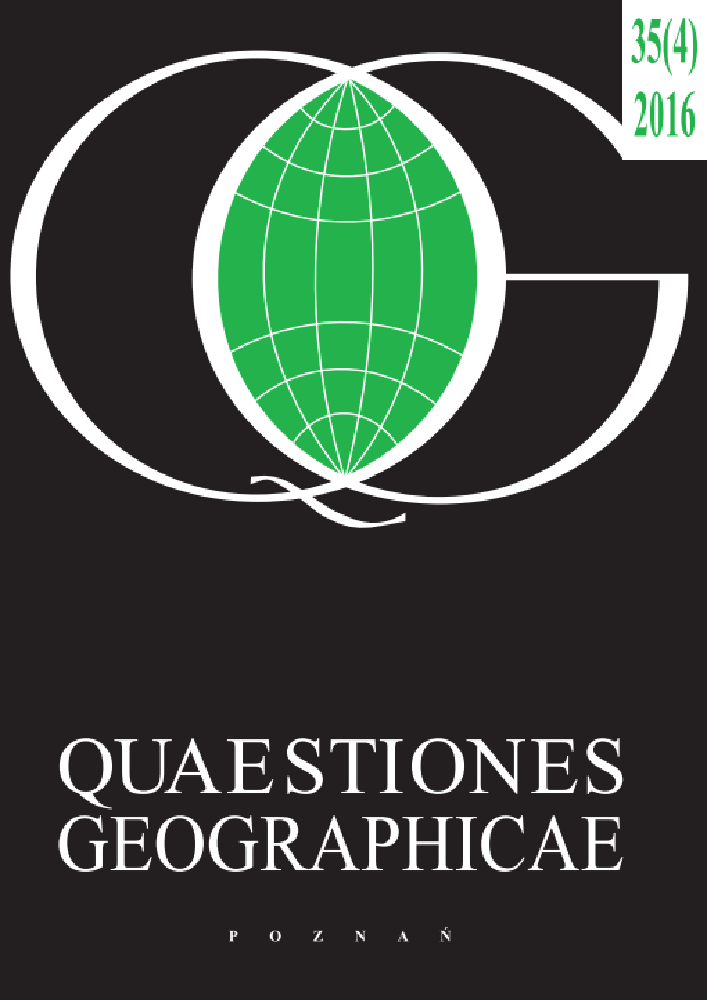Abstract
The article seeks to analyse the accessibility of hospital healthcare to inhabitants of Łódź voivodeship in 2015. The analysis comprises all the communes of the Łódź region as well as those of the neighbouring voivodeships from which the theoretical time of reaching hospitals in Łódź voivodeship does not exceed the maximum time assumed in the research. Accessibility was determined in reference to 51 hospitals, assuming that their ‘attractiveness’ was related to the number of permanent beds they offered. The research was conducted using the three-step floating catchment area method (3SFCA).
References
Anselin L., 1988. Spatial econometrics: Methods and models. Kluwer Academic Publishers, Dordrecht.
Chojnicki Z., 1966. Zastosowanie modeli grawitacji i potencjału w badaniach przestrzenno-ekonomicznych (The use of gravity and potential models in spatial-economic research). Studia KPZK PAN 14, Warsaw.
Drury P., 1983. Some spatial aspects of health service developments. Progress in Human Geography 7(1): 60–77.
Fortney J., Rost K., Warren J., 2000. Comparing alternative methods of measuring geographic access to health services.
Health Services & Outcomes Research Methodology 1(2): 173–184.
Fotheringham A.S., 1982. A new set of spatial-interaction models: The theory of competing destinations. Environment and Planning A 15: 15–36.
Geronimus A., Bound J,. Neidert L., 1996. On the validity of using census geocode characteristics to proxy individual socioeconomic characteristics. Journal of the American Statistical Association 91(434): 529–537.
Geurs K.T., Ritsema van Eck J.R., 2001. Accessibility measures: Review and applications. RIVM report 408505 006, NationalInstitute of Public Health and the Environment, Bilthoven.
Goodman D.C., Mick S.S., Bott D., Stukel T., Chang C.-H., Marth N., Poage J., Carretta H.J., 2003. Primary care service areas: A new tool for the evaluation of primary care services. Health Services Research 38(1): 287–309.
Guagliardo M.F., 2004. Spatial accessibility of primary care: Concepts, methods and challenges. International Journal of Health Geographics 3(3): 1–13.
Lin G., Allan D.E., Penning M.J., 2002. Examining distance effects on hospitalizations using GIS: A study of three health regions in British Columbia, Canada. Environment and Planning A 34(11): 2037–2053.
Luo W., Qi Y., 2009. An enhanced two-step floating catchment area (E2SFCA) method for measuring spatial accessibility of primary care physicians. Health and Place 15(4): 1100–1107.
Luo W., Wang F., 2003. Measures of spatial accessibility of healthcare in a GIS environment: Synthesis and a case study in the Chicago region. Environment and Planning B: Planning and Design 30: 865–884.
Martin D., Roderick P., Diamond I., Clements S., Stone N., 1998. Geographical aspects of the uptake of renal replacement therapy in England. International Journal of Population Geography 4(3): 227–242.
McGrail M.R., Humphreys J.S., 2009. Measuring spatial accessibility of primary care in rural areas: Improving the effectiveness of the two-step floating catchment area method. Applied Geography 29(4): 533–541.
Morrill R.L., Earickson R.J., 1968. Hospital variation and patient travel distances. Inquiry 5(4): 26-34.
Morrill R.L., Earickson R.J., 1969. Locational efficiency of Chicago hospitals. Health Services Research 4(2): 128–141.
Morrill R.L., Earickson R.J., Rees P., 1970. Factors influencing distances traveled to hospitals. Economic Geography 46(2): 161–171.
Morrill R.L., Kelley M.B., 1970. The simulation of hospital use and the estimation of location efficiency. Geographical Analysis 2(3): 283–300.
Morrill R.L., Kelley P., 1969. Optimum allocation of services: A hospital example. Annals of Regional Science 3(1): 55–66.
Ngui A.N., Apparicio P., 2011. Optimising the two-step floating catchment area method for measuring spatial accessibility of medical clinics in Montreal. BMC Health Services Research 11(1): 166.
Plan działania systemu Państwowe Ratownictwo Medyczne dla województwa łódzkiego z 23 czerwca 2015 r. (Operational Plan for Emergency Medical Services for Łódź voivodeship of June 23, 2015).
Polzin P., Borges J., Coelho A., 2014. An extended kernel density two-step floating catchment area method to analyze access to healthcare. Environment and Planning B: Planning and Design 41: 717–735.
Radke J., Mu L., 2000. Spatial decomposition, modeling and mapping service regions to predict access to social programs. Geographic Information Sciences 6: 105–112.
Rosik P., 2012. Dostępność lądowa przestrzeni Polski w wymiarze europejskim (Overland accessibility of Poland’s space in the European dimension). Prace Geograficzne 233, IGiPZ PAN, Warszawa.
Spiekermann K., Schürmann C., 2007. Update of selected potential accessibility indicators. Final report. Spiekermann & Wegener Urban and Regional Research (S&W), RRG
Spatial Planning and Geoinformation. Stępniak M., 2013. Wykorzystanie metody 2SFCA w badaniach dostępności przestrzennej usług medycznych (The use of the 2SFCA method in research on the spatial accessibility of medical services). Przegląd Geograficzny 35(2): 199–218.
Wan N., Zou B., Sternberg T., 2012. A three-step floating catchment area method for analysing spatial access to health services. International Journal of Geographical Information Science 26(6): 1073–1089.
Wiśniewski S., 2015. Transport accessibility differences of cities in Lodz region. Wydawnictwo Uniwersytetu Łódzkiego, Łódź.
Wyszewianski L., 2002. Access to care: Remembering old lessons. Health Services Research 37(6): 1441–1443. Brought
License
© Faculty of Geographical and Geological Sciences, Adam Mickiewicz UniversityThis work is licensed under the Creative Commons Attribution-NonCommercial-NoDerivatives 4.0 License.
